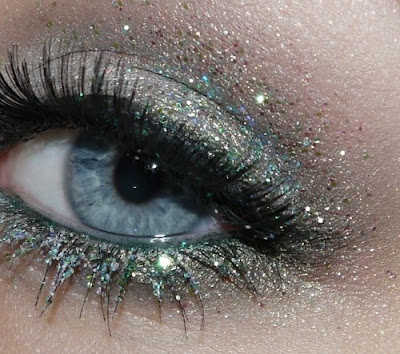"Glittering things attract people's attention effortlessly. If you want to be be a stunning eye-catcher, do a glitter makeup for yourself. It's easy for you to show off your magic fascination and wow people around you." So says Pretty Designs. com,
BUT WAIT
The sparkly glitter we enjoy using for makeup and craft projects is actually made from microplastic, one of the world's biggest environmental pollutants and potential killers of marine life. Those tiny plastic sparkles find their way down the drain and into the ocean where they contribute to the 51 trillion fragments of microparticles found floating there. It has been documented that there is plastic present in every third fish caught in the U.K. Soon there will be more plastic than fish in the sea. But there are easy ways to make small changes and one is to use products like the biodegradable glitter made by the Danish company Ecosparkles- here. Their glitter is a biodegradable alternative made of cellulose film and will prevent further damage to the environment. And it is compostable!
But glitter is just the tip of the iceberg. Our convenience-driven, throwaway, fast food culture indulges in plastic bottles, straws, plastic bags, lids and containers. These items are thrown away and survive forever in landfills or are washed into storm drains and out to sea. It's time for the plastic and oil industries to take some responsibility but instead they continue their deep-pocketed campaigns to quash anti-plastic legislation and discourage scientific research.
Yet there are men and women devoting their lives to studying the ecological impacts of plastic pollution and trying to find solutions. You can't delve far into that world before finding mention of Marcus Eriksen and his 5 Gyres Institute. He studies the global distribution and ecological impact of marine plastic waste by making sailing expeditions to destinations that include all 5 subtropical gyres, plus the Bay of Bengal and many inland lakes and rivers. He recently published the first global estimate of all plastic of all sizes floating in the world's oceans, which totals 270,000 metric tons.
 |
| Now you can make your mousepad from plastic free compostable glitter |
But glitter is just the tip of the iceberg. Our convenience-driven, throwaway, fast food culture indulges in plastic bottles, straws, plastic bags, lids and containers. These items are thrown away and survive forever in landfills or are washed into storm drains and out to sea. It's time for the plastic and oil industries to take some responsibility but instead they continue their deep-pocketed campaigns to quash anti-plastic legislation and discourage scientific research.
Yet there are men and women devoting their lives to studying the ecological impacts of plastic pollution and trying to find solutions. You can't delve far into that world before finding mention of Marcus Eriksen and his 5 Gyres Institute. He studies the global distribution and ecological impact of marine plastic waste by making sailing expeditions to destinations that include all 5 subtropical gyres, plus the Bay of Bengal and many inland lakes and rivers. He recently published the first global estimate of all plastic of all sizes floating in the world's oceans, which totals 270,000 metric tons.
 |
| Marcus Eriksen's Junk Raft sailing to Honolulu |
In 2017 Eriksen's book Junk Raft was published by Beacon Press. It chronicles his journey from Los Angeles to Honolulu in 88 days using the North Pacific Gyre's swirling current. The motorless "junk raft" floated on six pontoons made of 15,000 recycled plastic bottles and carried a Cessna plane body where the two sailors ate, slept and kept provisions. He tells the story of how plastic pollution at sea was discovered, the impact on people and the planet, and the growing movement to solve the problem through zero waste initiatives in the largest cities worldwide.
California, as well as many cities around the United States, has banned plastic bags. Now it's up to consumers to stop being wasteful and come a notch closer to that zero waste ideal. Carolyn Jones, an East Bay freelance writer suggests, "Why not ban more non-biodegradable products? Let's ban plastic water bottles for starters. Who thought those were a good idea anyway?" And for the real deal please, check out the Blog "My Plastic Free Life." Can we do it? Let's try!
